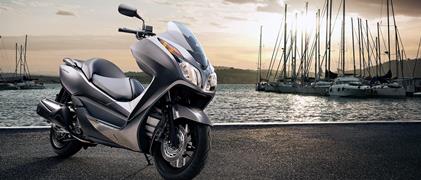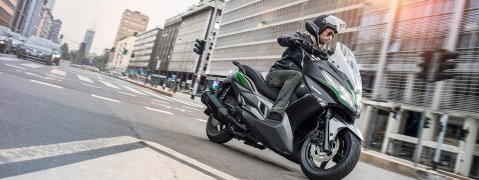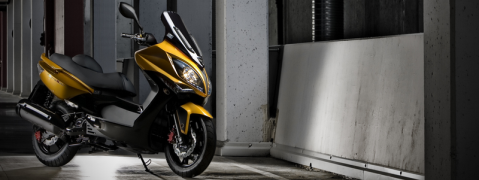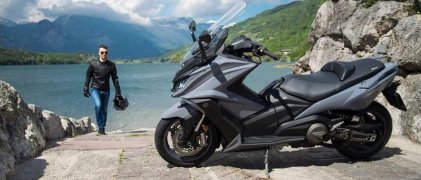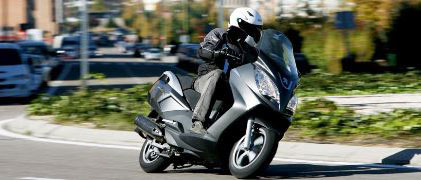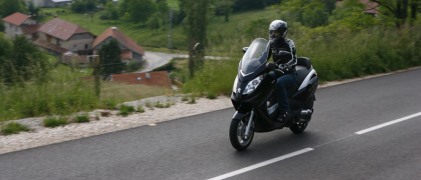 Honda NSS300 Forza - Owner's Manual > Engine Oil
Honda NSS300 Forza - Owner's Manual > Engine Oil
Engine oil consumption varies and oil quality deteriorates according to riding conditions and time elapsed.
Check the engine oil level regularly, and add the recommended engine oil if necessary. Dirty oil or old oil should be changed as soon as possible.
Selecting the Engine Oil
For recommended engine oil, see "Specifications". If you use non-Honda engine oil, check the label to make sure that the oil satisfies all of the following standards:
- JASO T 903 standard*1: MB
- SAE standard*2: 10W-30
- API classification*3: SG or higher
*1. The JASO T 903 standard is an index for engine oils for 4-stroke motorcycle engines. There are two classes: MA and MB. For example, the following label shows the MB classification.

*2. The SAE standard grades oils by their viscosity.
*3. The API classification specifies the quality and performance rating of
engine oils. Use SG or higher oils, excluding oils marked as "Energy Conserving"
or "Resource Conserving" on the circular API service symbol.

Brake Fluid
Do not add or replace brake fluid, except in an emergency. Use only fresh brake fluid from a sealed container. If you do add fluid, have the brake system serviced by your dealer as soon as possible.
NOTICE Brake fluid can damage plastic and painted surfaces.
Wipe up spills immediately and wash thoroughly.
Recommended brake fluid:
Honda DOT 4 Brake Fluid or equivalent
Recommended Coolant
Pro Honda HP is a pre-mixed solution of antifreeze and distilled water.
Concentration:
50% antifreeze and 50% distilled water
A concentration of antifreeze below 40% will not provide proper corrosion and cold temperature protection.
A concentration of up to 60% will provide better protection in colder climates.
NOTICE Using coolant not specified for aluminium engines or ordinary tap water can cause corrosion.
Crankcase Breather
Service more frequently when riding in rain, at full throttle, or after the scooter is washed or overturned. Service if the deposit level can be seen in the transparent section of the drain tube.
Tyres (Inspecting/Replacing)
Checking the Air Pressure
Visually inspect your tyres and use an air pressure gauge to measure the air pressure at least once a month or any time you think the tyres look low. Always check air pressure when your tyres are cold.
Inspecting for Damage

Inspect the tyres for cuts, slits, or cracks that exposes fabric or cords, or nails or other foreign objects embedded in the side of the tyre or the tread. Also inspect for the bumps or bulges in the side walls of the tyres.
Inspecting for Abnormal Wear

Inspect the tyres for signs of abnormal wear on the contact surface.
Inspecting Tread Depth
Inspect the tread wear indicators. If they become visible, replace the tyres immediately.
For safe riding, you should replace the tyres when the minimum tread depth is reached.

WARNING
Riding on tyres that are excessively worn or improperly inflated can cause a crash in which you can be seriously hurt or killed.
Follow all instructions in this owner's manual regarding tyre inflation and maintenance.
Germany
German law prohibits use of tyres whose tread depth is less than 1.6 mm.
Have your tyres replaced by your dealer.
For recommended tyres, air pressure and minimum tread depth, see "Specifications".
Follow these guidelines whenever you replace tyres.
- Use the recommended tyres or equivalents of the same size, construction, speed rating, and load range.
- Have the wheel balanced with Honda Genuine balance weights or equivalent after the tyre is installed.
- Do not install a tube inside a tubeless tyre on this scooter. Excessive heat build-up can cause the tube to burst.
- Use only tubeless tyres on this scooter. The rims are designed for tubeless tyres, and during hard acceleration or braking, a tube-type tyre could slip on the rim and cause the tyre to rapidly deflate.
WARNING
Installing improper tyres on your scooter can adversely affect handling and stability, and can cause a crash in which you can be seriously hurt or killed.
Always use the size and type of tyres recommended in this owner's manual.
Air Cleaner
This scooter is equipped with a viscous type air cleaner element.
Compressed air cleaning or any other cleaning can degrade the viscous element performance and cause the intake of dust.
Do not perform the maintenance.
Should be serviced by your dealer.

Tool Kit
The tool kit is in the luggage box.
You can perform some roadside repairs, minor adjustments and parts replacement with the tools contained in the kit.
- Spark plug wrench
- 10 Ă— 14 mm Open end wrench
- 12 Ă— 14 mm Open end wrench
- Standard/Phillips screwdriver
- Screwdriver grip
- Helmet set wire
- Fuse puller
- Pin spanner
- Eye wrench handle
See also:
 Honda NSS300 Forza - Owner's Manual > Pre-ride Inspection
Honda NSS300 Forza - Owner's Manual > Pre-ride Inspection
To ensure safety, it is your responsibility to perform a pre-ride inspection and make sure that any problem you find is corrected. A preride inspection is a must, not only for safety, but because having a breakdown, or even a flat tyre, can be a major inconvenience.
 Honda NSS300 Forza - Owner's Manual > Removing & Installing Body Components
Honda NSS300 Forza - Owner's Manual > Removing & Installing Body Components
Battery Cover The battery cover must be removed to remove the battery, to service the fuse box and fuse holder fuses.

